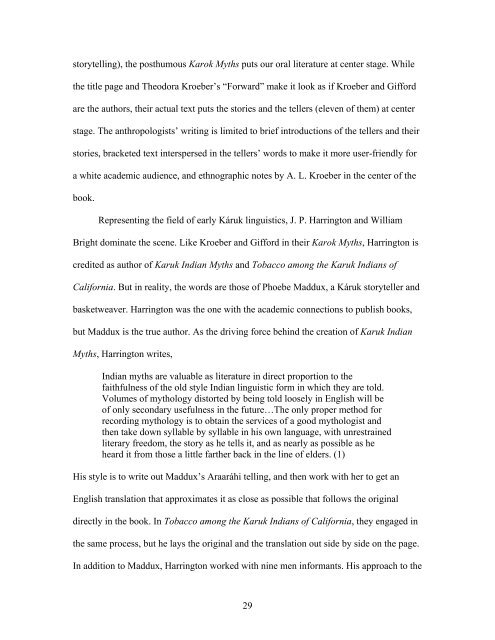The Intersection of Karuk Storytelling and Education
The Intersection of Karuk Storytelling and Education
The Intersection of Karuk Storytelling and Education
You also want an ePaper? Increase the reach of your titles
YUMPU automatically turns print PDFs into web optimized ePapers that Google loves.
storytelling), the posthumous Karok Myths puts our oral literature at center stage. While<br />
the title page <strong>and</strong> <strong>The</strong>odora Kroeber’s “Forward” make it look as if Kroeber <strong>and</strong> Gifford<br />
are the authors, their actual text puts the stories <strong>and</strong> the tellers (eleven <strong>of</strong> them) at center<br />
stage. <strong>The</strong> anthropologists’ writing is limited to brief introductions <strong>of</strong> the tellers <strong>and</strong> their<br />
stories, bracketed text interspersed in the tellers’ words to make it more user-friendly for<br />
a white academic audience, <strong>and</strong> ethnographic notes by A. L. Kroeber in the center <strong>of</strong> the<br />
book.<br />
Representing the field <strong>of</strong> early Káruk linguistics, J. P. Harrington <strong>and</strong> William<br />
Bright dominate the scene. Like Kroeber <strong>and</strong> Gifford in their Karok Myths, Harrington is<br />
credited as author <strong>of</strong> <strong>Karuk</strong> Indian Myths <strong>and</strong> Tobacco among the <strong>Karuk</strong> Indians <strong>of</strong><br />
California. But in reality, the words are those <strong>of</strong> Phoebe Maddux, a Káruk storyteller <strong>and</strong><br />
basketweaver. Harrington was the one with the academic connections to publish books,<br />
but Maddux is the true author. As the driving force behind the creation <strong>of</strong> <strong>Karuk</strong> Indian<br />
Myths, Harrington writes,<br />
Indian myths are valuable as literature in direct proportion to the<br />
faithfulness <strong>of</strong> the old style Indian linguistic form in which they are told.<br />
Volumes <strong>of</strong> mythology distorted by being told loosely in English will be<br />
<strong>of</strong> only secondary usefulness in the future…<strong>The</strong> only proper method for<br />
recording mythology is to obtain the services <strong>of</strong> a good mythologist <strong>and</strong><br />
then take down syllable by syllable in his own language, with unrestrained<br />
literary freedom, the story as he tells it, <strong>and</strong> as nearly as possible as he<br />
heard it from those a little farther back in the line <strong>of</strong> elders. (1)<br />
His style is to write out Maddux’s Araaráhi telling, <strong>and</strong> then work with her to get an<br />
English translation that approximates it as close as possible that follows the original<br />
directly in the book. In Tobacco among the <strong>Karuk</strong> Indians <strong>of</strong> California, they engaged in<br />
the same process, but he lays the original <strong>and</strong> the translation out side by side on the page.<br />
In addition to Maddux, Harrington worked with nine men informants. His approach to the<br />
29
















